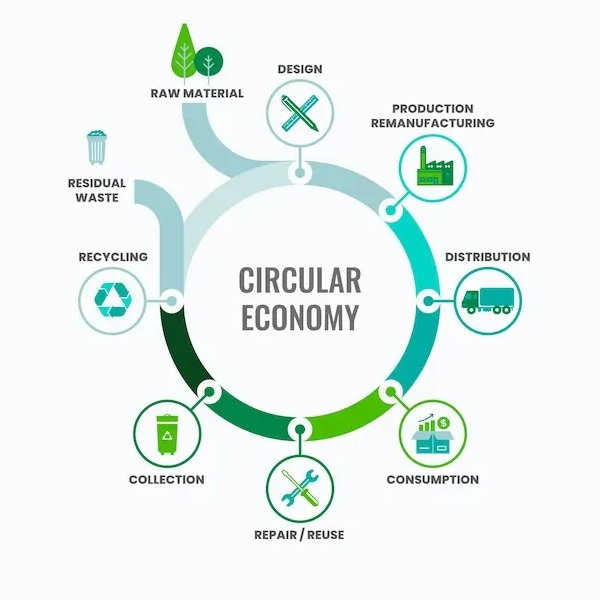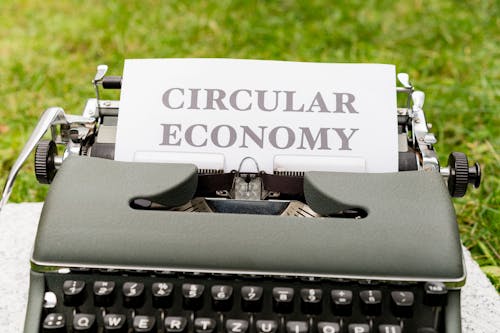The global economy has long operated under a model of scarcity—where resources are finite, consumption is linear, and waste is a byproduct of production. This model, while instrumental in driving industrial growth and development, is increasingly being challenged by the pressing issues of resource depletion, environmental degradation, and climate change. Enter the circular economy: a transformative approach that shifts the focus from scarcity to abundance by redesigning systems to keep resources in use for as long as possible, extract the maximum value from them, and regenerate natural systems.
![]()
This article explores the business models that are emerging within this new economic framework, offering insights into how companies can transition from traditional linear practices to circular ones.
The Circular Economy: An Overview
The circular economy is a systemic approach to economic development designed to benefit businesses, society, and the environment. Unlike the traditional linear economy, which follows a ‘take-make-dispose’ pattern, the circular economy aims to close the loop by keeping products, materials, and resources in circulation. This is achieved through principles such as designing out waste and pollution, keeping products and materials in use, and regenerating natural systems.
According to research by the Ellen MacArthur Foundation, the circular economy could generate $4.5 trillion in economic benefits by 2030 by transforming the way products are designed, used, and recycled. This shift from a linear to a circular model is not just an environmental imperative but also an economic opportunity, enabling businesses to reduce costs, enhance competitiveness, and create new value propositions.

The Drivers of Change: Why Transition to a Circular Economy?
Several factors are driving the transition from a linear to a circular economy:
1. Resource Depletion and Environmental Impact
The global demand for resources is outstripping the planet’s ability to supply them sustainably. The extraction and processing of materials contribute significantly to environmental degradation, including deforestation, soil erosion, water scarcity, and biodiversity loss. The circular economy offers a way to decouple economic growth from resource use and environmental impact.
2. Regulatory Pressures
Governments worldwide are introducing regulations and policies to promote circular practices. The European Union, for example, has adopted a Circular Economy Action Plan, which sets out measures to ensure that products are designed to last longer, are easier to repair and recycle, and contain recycled content.
3. Consumer Demand
Consumers are increasingly aware of the environmental impact of their purchases and are demanding more sustainable products and services. A 2021 study by IBM found that 57% of consumers are willing to change their purchasing habits to help reduce negative environmental impact.
4. Technological Advancements
Innovations in digital technology, such as the Internet of Things (IoT), blockchain, and artificial intelligence (AI), are enabling new circular business models by providing the tools to track, trace, and optimize resource use across the value chain.
5. Economic Resilience
The COVID-19 pandemic has exposed the vulnerabilities of global supply chains and underscored the importance of resilience. Circular business models, with their emphasis on local sourcing, resource efficiency, and waste minimization, offer a pathway to greater economic resilience.
Business Models in the Circular Economy
As businesses look to transition from a linear to a circular economy, several innovative business models are emerging. These models not only reduce waste and conserve resources but also open up new revenue streams and enhance competitiveness.
1. Product-as-a-Service (PaaS)
The Product-as-a-Service (PaaS) model shifts the focus from selling products to providing services. Instead of purchasing a product outright, customers pay for the service that the product provides. This model encourages companies to design products that are durable, easy to repair, and recyclable, as they retain ownership and responsibility for the product throughout its lifecycle.
2. Sharing Economy
The sharing economy leverages the underutilized capacity of assets by enabling multiple users to share access to products and services. This model maximizes the use of resources and reduces the need for new products, thereby minimizing waste and resource consumption.
3. Circular Supply Chains
Circular supply chains involve the continuous flow of products and materials within the economy, minimizing waste and reducing the need for virgin resources. This model emphasizes the use of recycled and renewable materials, as well as the recovery and repurposing of products at the end of their life.
4. Product Life Extension
Product life extension involves strategies to extend the lifespan of products through maintenance, repair, refurbishment, and remanufacturing. By keeping products in use for longer, businesses can reduce waste and resource consumption while offering customers greater value.
5. Resource Recovery
Resource recovery involves the extraction of valuable materials from waste streams, turning waste into a resource. This model is particularly relevant in industries such as manufacturing, where waste byproducts can be recycled or repurposed into new products.

photo credit: Markus Winkler / Pexels
Challenges and Opportunities in the Circular Economy
While the circular economy presents significant opportunities, businesses also face challenges in making the transition. These challenges include:
1. Cultural Shift
Moving from a linear to a circular economy requires a fundamental shift in mindset, both within companies and among consumers. Businesses must foster a culture of innovation, collaboration, and sustainability, while consumers need to embrace new ways of accessing products and services.
2. Infrastructure and Technology
Implementing circular business models often requires new infrastructure and technology. For example, the sharing economy relies on digital platforms to connect users, while resource recovery requires advanced recycling technologies. Businesses must invest in the necessary infrastructure and technology to support circular practices.
3. Regulatory Barriers
In some regions, regulatory frameworks are still designed around the linear economy, creating barriers to circular practices. Governments must adapt regulations to support circular business models, such as by providing incentives for the use of recycled materials and penalizing wasteful practices.
4. Measuring Impact
Measuring the impact of circular practices can be challenging, as traditional metrics may not fully capture the benefits of resource efficiency and waste reduction. Businesses need to develop new metrics to measure the success of circular initiatives and communicate their impact to stakeholders.
Despite these challenges, the opportunities presented by the circular economy are vast. Businesses that successfully transition to circular models can benefit from cost savings, new revenue streams, enhanced brand reputation, and increased resilience. Moreover, the circular economy offers a pathway to sustainable growth, enabling businesses to thrive in a resource-constrained world.
Conclusion: Embracing the Future of Abundance
The transition from scarcity to abundance through the circular economy represents a profound shift in how we think about resources, production, and consumption. By embracing circular business models, companies can not only reduce their environmental impact but also unlock new economic opportunities and create value for customers, shareholders, and society at large.
As we move towards a more sustainable future, the circular economy will play a crucial role in shaping the next generation of business models. Companies that lead the way in adopting circular practices will be well-positioned to thrive in an economy where abundance, rather than scarcity, is the guiding principle.


